Remembered 48 years later, Respect. Respect. Respect.
LIFE Magazine
1/24/1964 Excerpts from the Editorial on p. 4:
That
President Johnson's first
international crisis has occurred in
Latin America
ought to come as no surprise, if only because Latin
America
is Castro's stalking
ground. But Panama need not have been the trouble
spot. Crisis there had been
forecast for years, by observers and by
events.
[...]
As owner and operator of the Canal Company, the U.S.
government
has blindly
allowed the Canal Zone to turn into a pretty fair imitation
of a colony, complete
with a colonial mentality. In the Zone,
discrimination
against Panamanians
has existed since the beginning, backed up by wage
differentials, special
privileges for Americans and all the
paraphernalia
of extra-territoriality.
Isolated and pampered, permitted to stay on as
settlers instead of being rotated
back to the states, the few thousand
Zonians developed a misplaced sense of
patriotism which made them
roundly
disliked and which -- as expressed by
the high school kids and their
flag
-- touched off the latest anti-American demonstrations.
|
|
Two flags
LIFE Magazine: "It all began because there was one vacant flagpole at
Balboa High School."
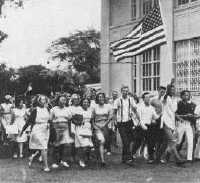
In 1960,
after a series
of riots in Panama, President Eisenhower ordered
that Panama's flag should fly side by side with the Stars and Stripes
at
the U.S. Canal Zone building. President Kennedy later extended the
order
to the rest of the enclave. Since the chief objections to this
broadened
directive came from American students, with parental encouragement,
zone
officials ordered that, as of Jan. 1, no flags should be flown in front
of schools. Outraged, Zonian teenagers saw the empty flagpoles as a
challenge
not to be ignored.
|
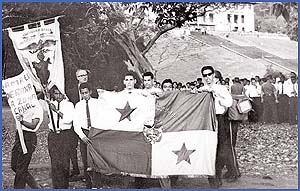
On January 9, 1964, at 4:50 PM, around 200 male and female students exited the Instituto Nacional heading to the Balboa High School to hoist the Panamanian flag. During the walk, students stopped singing the national anthem to pay respect to the sick at the Gorgas Hospital. Two police cars headed the peaceful manifestation. Guevara Paz and Francisco Diaz made a deal with the Zonian officials to accept a six-student delegation, among them the Instituto Nacional flag bearer, and a classmate who was carrying a banner which read: "Panama is sovereign in the Canal Zone". The delegation arrived close to the flagpole area to sing the national anthem and raise the Panamanian flag at the Balboa High School, where mainly zonian students attended.
On the balconies and at the entrance of the high school was a hostile crowd of approximately 2000 zonians. Suddenly, the six-student delegation from the Instituto Nacional was surrounded by hundreds of students and adult zonians.
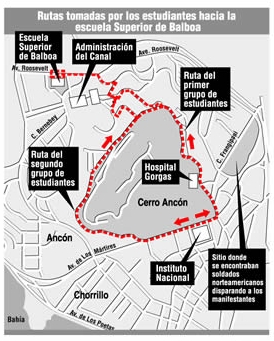 What really occured?
What really occured?
The Instituto Nacional flag bearer named Carranza describes it as follows:
"They slowly gathered around us. One shouted, then another one, then everybody. They started pushing us, and tried to take away the flag violently, while they insulted us".
The feeling of patriotism fogged the "Instituto Nacional" students eyes when a policeman from the "Canal Zone" ripped apart the Panamanian flag by using a stick. During the commotion, multiple hands pulled and tore the flag.
In the middle of "raining sticks", the students ran to protect the flag.
Somebody pointed at the United States flag on top of the Administration building, with the intention of getting back at the offense, however, zonian patrol cars and police had already taken their weapons out, and from the civil population homes, guns were already showing.
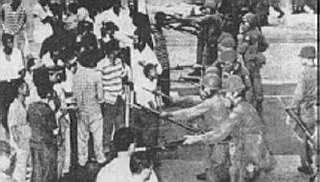
The massacre
On the way back, Guillermo Guevara Paz and
Rogelio Hilton, president
of the association for the senior class at the Instituto Nacional,
and
classmates destroyed a construction scaffolding from the Gorgas
Hospital
and threw it on the streets in an attempt to deter the ferocity of
their
followers.
They started hearing similar noises to firecrackers, but since it was not the 4th of July, the US independence holiday, they realized they were gun shots.
They did not come from police patrols, but from the houses next to the Episcopal church, where numerous adult zonians were.
It was around 6:30 pm when they crossed the "4th of July" avenue and arrived at the "Calle J" bus stop. News spread along the city and canal zone limits.
Hundreds of students and people, indignant about the offense to the Panamanian flag, started throwing rocks at the students and adult zonians.
The first wounded began to appear; Ascanio Arosemena's shoulders were bloody from all the wounded he had carried, but a bullet from a caliber-22 rifle made him the first martyr.
They started hearing similar noises to firecrackers, but since it was not the 4th of July, the US independence holiday, they realized they were gun shots.
They did not come from police patrols, but from the houses next to the Episcopal church, where numerous adult zonians were.
It was around 6:30 pm when they crossed the "4th of July" avenue and arrived at the "Calle J" bus stop. News spread along the city and canal zone limits.
Hundreds of students and people, indignant about the offense to the Panamanian flag, started throwing rocks at the students and adult zonians.
The first wounded began to appear; Ascanio Arosemena's shoulders were bloody from all the wounded he had carried, but a bullet from a caliber-22 rifle made him the first martyr.
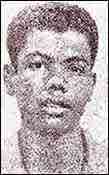 Ascanio Arosemena
Ascanio ArosemenaA high school student who was shot and killed while trying to help the wounded to safety, the first of 22 Panamanian dead.
Points of view
No
U.S. sources refer to the
civilian 'Zonians' doing any shooting.
A report by Captain
Gaddis Wall of the Canal Zone Police said "Since there was
scuffling,
pushing, and physical struggle between the Canal Zone police and the
Panamanian
students, the four Panama students holding the flag apparently tore it
themselves during the scuffle." The LIFE magazine reported, "When
rumors
spread that their flag had been desecrated, a mob, spurred on by Castro
agents, gathered in the streets and snipers began to attack U.S.-owned
buildings." Fears of Cuban influence were apparently strong. Another
article
from La
Prensa by Betty Brannan Jaén indicated President Lyndon
Johnson was
convinced the disturbances were 'inspired by Communists.'
LIFE: "The fighting, which resulted in the
deaths of four U.S. soldiers
and 19 Panamanians [actually 22], began after U.S. and Panamanian
students
clashed over whose flags would fly in the U.S.-administered zone. But
it
was fed by years of Panamanian discontent over the canal, by
troublesome
Castro agents, and by the presence of patriotic but misguided Americans
who did not realize that they were away from home." The LIFE reporters interviewed other U.S. 'Zonians' - "There were other interviews - many of them. These Zonians scattered the blame widely among Latin American politicians, Communists, Castroites, hoodlums, hot-tempered Panamanian students, irresponsible Panamanian radio broadcasts. None accepted any responsibility whatever for the shedding of blood."
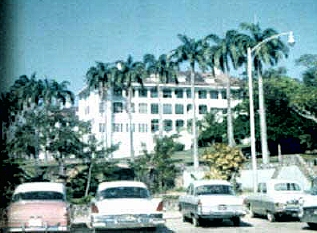
A Panamanian friend remembers, "I was 8 years old on January 9, 1964. Up to this date, I can still hear the shots from the US army against the Panamanian nationals. Those of us that lived those years will always remember that, as well as the apartheid-driven canal zone." He also said, "I lived about one mile from the site, and remember hearing the shots as it was yesterday. I also remember crawling in the floor, in case a bullet went thru a window. Most of the killing was done by snipers that were strategically housed in the Tivoli Hotel, which doesn't exist anymore. The Smithsonian Tropical Research Institute now stands at that site. The fellows in the Tivoli really had a ball shooting at anything that moved. Being a kid, that really had an impact on me."
The Tivoli Hotel
Rubén Blades:
"Something snapped [in me]. I couldn't justify this. They [the U.S.] were supposed to be the good guys."
(New York
Magazine
8/18/85
"They turned friends into
enemies.
Even today, that's the pity of U.S. policy in Latin America."
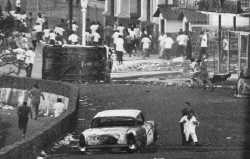
"Rioters rescue
a comrade shot trying
to enter
the U.S. zone. The man
was
not shot by U.S. troops. [...] In the
early stages of the rioting,
before
the Army took over, the Canal Zone
U.S. police were in charge.
Using
tougher tactics, they were reported to
have fired directly into the
mob."
(LIFE)
From the Latin
American Data Base
: "Riots ensued, street fighting
between U.S. military
personnel and Panamanians, resulting in $2 million
in property burned
or
otherwise destroyed (mainly US), 28 dead,
300 wounded and 500 arrested.
Panama broke relations with the US for
several days.
From Historical
Text Archive
: President Chiari demanded an OAS
and United Nations
investigation of what he called US aggression
and suspended diplomatic
relations.
Shortly thereafter, negotiations on a new treaty began.
|
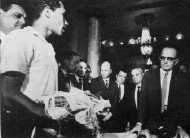
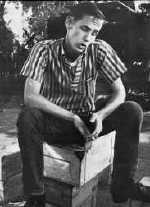
No comments:
Post a Comment